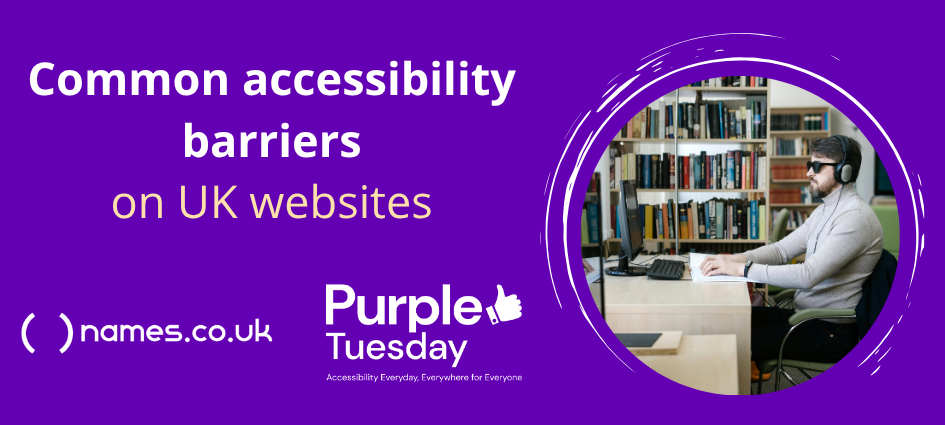This year we’re proud to support Purple Tuesday on 4th November.
Purple Tuesday is a national campaign designed to raise awareness about the challenges faced by people with disabilities.
Many businesses cover the basics by adding access ramps, lifts and wide aisles to accommodate wheelchair users. But accessibility isn’t just about physical needs. There are digital concerns to think about as well. What if someone with a visual or motor impairment wants to use the website? Are they going to be able to have the same experience on there as everyone else?
We were curious exactly how widespread this problem was, so we recently analysed almost 150,000 UK websites to find out. We discovered that around 80% of them had at least 1 accessibility issue and the average website had no less than 25 individual concerns that would present barriers to certain users.
Key Findings
| Main content not clear 33% | Poor colour contrast 30% | Image Descriptions 4% |
It’s clear that many UK websites still present serious challenges for disabled users. Despite clear legal obligations under the Equality Act 2010 and the Public Sector Bodies Accessibility Regulations 2018, barriers persist across both public and private sectors. These issues aren’t just technical oversights – they exclude millions of people from accessing essential services and information.
In this post we’ll shed a light on the everyday challenges faced by disabled people when using the internet.
Poor colour contrast
One of the most common problems is poor colour contrast. In fact, 30% of the websites we analysed were affected by this. Text that blends into its background can be unreadable for users with low vision or colour blindness. This isn’t limited to obscure sites; even major retailers have been flagged for failing basic contrast checks. A recent audit* of the UK’s top 100 retail websites found that 84% had critical accessibility issues, including low contrast ratios and missing image descriptions.
Images without descriptions
The term “alt text” refers to text that describes what an image is depicting. When images lack these descriptive tags, screen reader users are left without context. This is especially problematic when images convey key information, such as charts or buttons. Decorative images should be marked with empty alt attributes, but informative ones need clear descriptions. Without this key descriptive text blind users, or those with a visual impairment, would struggle to understand what it is that the image is supposed to be telling them.
Keyboard navigation
Keyboard navigation is often overlooked. Many websites assume users will navigate with a mouse, but that’s not always possible. People with motor impairments or those using assistive technology rely on keyboard-only access. If a site traps users in modal windows or doesn’t allow tabbing through menus, it becomes unusable.
PDFs
PDFs pose their own challenges. Inaccessible forms and documents are still widely used, particularly on council and government sites. These files often lack proper tagging, making them unreadable by screen readers. A study by digital disability charity Scope found that 90% of top local authority websites failed basic accessibility tests, with PDFs being a major culprit.
Incorrect headings
Incorrect heading structures can also disrupt navigation. Screen readers use headings to understand page layout and content hierarchy. When headings are skipped or used inconsistently, users struggle to find what they need. This isn’t just a nuisance – it’s a barrier to independent access. A third of the websites we analysed all had some form of problem with the main content not being laid out in a logical order, with clearly structured and semantically correct headings.
Font size & appearance
You may be able to read the text on your website OK, but can everyone else? If people have to squint to see the words they’ll soon go elsewhere. It’s important that website text is clearly laid out and is a reasonable size. An accessible website would offer its users the ability to adjust the font size at will, enlarging or shrinking it to suit their own needs. You should also consider the places where you may be using decorative fonts. They may look pretty in a logo, but can they be easily read if used in normal text?
Why is an accessible website important?
Accessibility isn’t optional. It’s a legal requirement and a moral obligation. With around 16 million disabled people in the UK*, inclusive design should be standard practice. Fixing these barriers doesn’t just help disabled users – it improves usability for everyone.
Become more inclusive today
Play your part in creating a fairer Internet for all by making your own website much more accessible to those with disabilities. Our WayWidget web accessibility solution is quick and easy to install, allowing you to offer a personalised and inclusive experience to all those with disabilities. It’s not the “be all and end all”, but it’s certainly a great starting point from which to begin your web accessibility journey.
*Sources: https://internetretailing.net/8-in-10-top-uk-retail-websites-have-critical-accessibility-issues/ & https://commonslibrary.parliament.uk/research-briefings/cbp-9602/
